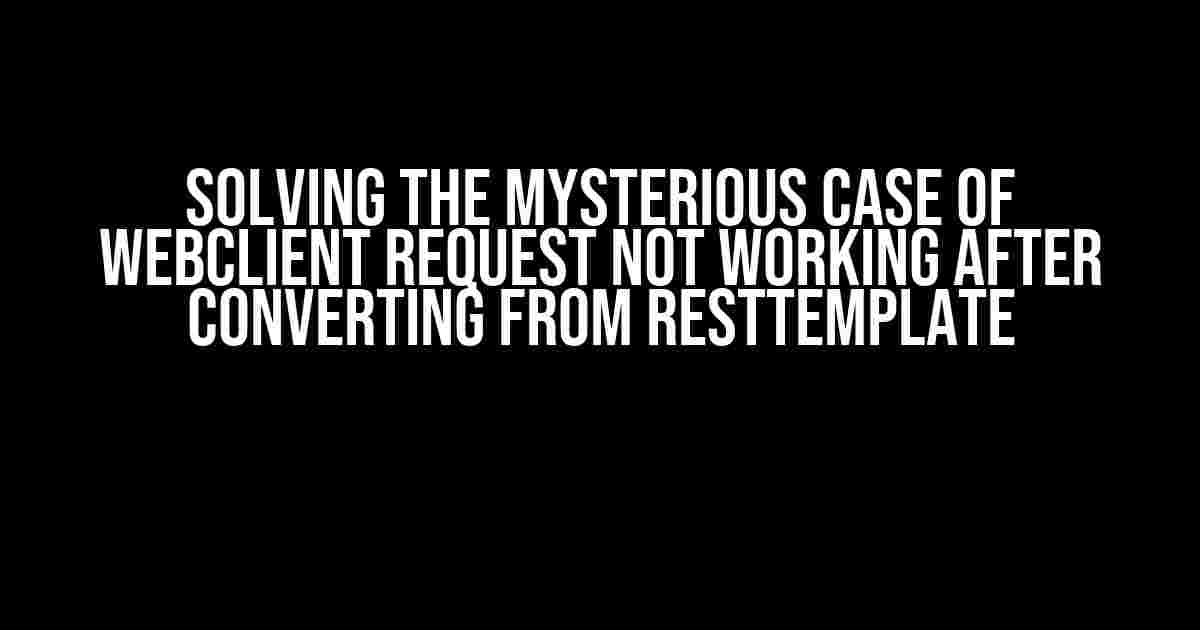Are you stuck in a rut, trying to figure out why your WebClient request isn’t working after converting from RestTemplate? Well, buckle up, friend, because we’re about to dive into the depths of this issue and emerge victorious on the other side!
- The Scenario: A Brief Background
- The Culprit: Understanding the Differences Between RestTemplate and WebClient
- The Investigation: Common Pitfalls When Converting from RestTemplate to WebClient
- The Solution: A Step-by-Step Guide to Converting from RestTemplate to WebClient
- Conclusion
- Bonus Section: Additional Tips and Best Practices
The Scenario: A Brief Background
Imagine you’ve been using Spring’s RestTemplate to make HTTP requests in your application, but for reasons unknown (maybe you wanted to switch to a more modern approach or your team decided to standardize on WebClient), you’ve decided to make the switch to WebClient. You’ve carefully rewritten your code, but to your surprise, your requests are no longer working as expected. Errors abound, and you’re left scratching your head, wondering what went wrong.
The Culprit: Understanding the Differences Between RestTemplate and WebClient
The key to solving this mystery lies in understanding the fundamental differences between RestTemplate and WebClient. RestTemplate is a synchronous, blocking, and template-based framework for making HTTP requests, whereas WebClient is an asynchronous, non-blocking, and functional programming model for making HTTP requests.
Here’s a brief breakdown of the main differences:
| Feature | RestTemplate | WebClient |
|---|---|---|
| Synchronous/Asynchronous | Synchronous | Asynchronous |
| Blocking/Non-Blocking | Blocking | Non-Blocking |
| Programming Model | Template-based | Functional |
The Investigation: Common Pitfalls When Converting from RestTemplate to WebClient
Now that we’ve covered the basics, let’s dive into the common pitfalls that might be causing your WebClient request to fail:
Pitfall 1: Incorrect Import Statements
Make sure you’ve imported the correct WebClient classes and not mistakenly imported the RestTemplate classes.
import org.springframework.web.reactive.function.client.WebClient;
Pitfall 2: Misconfigured WebClient Builder
Verify that your WebClient builder is properly configured. Pay attention to the base URL, default headers, and other settings that might be specific to your application.
WebClient webClient = WebClient.builder()
.baseUrl("https://api.example.com")
.defaultHeader("Accept", "application/json")
.build();
Pitfall 3: Incorrect Request Method
Double-check that you’re using the correct request method (e.g., GET, POST, PUT, DELETE) and that it matches the expectation of the API you’re calling.
Mono response = webClient.get()
.uri("/users")
.retrieve()
.bodyToMono(String.class);
Pitfall 4: Missing or Incorrect Request Headers
Ensure that you’re setting the required request headers, such as Content-Type, Accept, or Authentication headers.
Mono response = webClient.get()
.uri("/users")
.header("Authorization", "Bearer your-token")
.retrieve()
.bodyToMono(String.class);
Pitfall 5: Asynchronous vs. Synchronous Programming
Remember that WebClient is an asynchronous, non-blocking API. Make sure you’re handling the response correctly, using methods like `block()`, `thenReturn()`, or `doOnNext()`.
Mono response = webClient.get()
.uri("/users")
.retrieve()
.bodyToMono(String.class)
.doOnNext(res -> System.out.println(res));
The Solution: A Step-by-Step Guide to Converting from RestTemplate to WebClient
Now that we’ve covered the common pitfalls, let’s walk through a step-by-step guide to converting from RestTemplate to WebClient:
Step 1: Create a WebClient Instance
WebClient webClient = WebClient.builder()
.baseUrl("https://api.example.com")
.defaultHeader("Accept", "application/json")
.build();
Step 2: Define the Request
Mono response = webClient.get()
.uri("/users")
.retrieve()
.bodyToMono(String.class);
Step 3: Handle the Response
response.doOnNext(res -> System.out.println(res));
Step 4: Add Error Handling (Optional)
response.onErrorResume(throwable -> Mono.error(new CustomException(throwable.getMessage())));
Conclusion
With these steps and careful attention to the differences between RestTemplate and WebClient, you should be able to successfully convert your RestTemplate code to WebClient and get your requests working again.
Remember, the key to solving this mystery lies in understanding the fundamental differences between the two APIs and avoiding the common pitfalls that can cause issues when converting from RestTemplate to WebClient.
Good luck, and happy coding!
Bonus Section: Additional Tips and Best Practices
Tips for Debugging WebClient Requests
When debugging WebClient requests, use the `exchange()` method to get more detailed information about the request and response.
Mono response = webClient.get()
.uri("/users")
.exchange();
Best Practices for WebClient Error Handling
Use `onErrorResume()` or `onErrorMap()` to handle errors and provide a fallback response or rethrow a custom exception.
response.onErrorResume(throwable -> Mono.error(new CustomException(throwable.getMessage())));
Optimizing WebClient Performance
Use caching, connection pooling, and timeouts to optimize WebClient performance and reduce the load on your application and the API you’re calling.
webClient = WebClient.builder()
.baseUrl("https://api.example.com")
.defaultHeader("Accept", "application/json")
.connectTimeout(Duration.ofSeconds(10)) // 10 seconds timeout
.build();
Here is the HTML code with 5 Questions and Answers about “WebClient request not working after converting from Rest Template”:
Frequently Asked Question
Get the solutions to the most common issues when switching from Rest Template to WebClient request!
What’s the main difference between Rest Template and WebClient that’s causing my request to fail?
Rest Template uses blocking I/O, whereas WebClient uses non-blocking I/O. WebClient also uses the new HttpClient, which has different configuration and connection handling. These changes can lead to differences in request processing and caching, causing your request to fail.
How do I set the headers and query parameters in WebClient like I did in Rest Template?
You can set headers and query parameters using the `HttpClient` instance. For headers, use `client.DefaultRequestHeaders.Add()`, and for query parameters, use `new Uri(queryString, UriKind.Relative)`. Note that WebClient uses the `GetAsync` method, which takes a `Uri` as an argument.
What about timeouts? How do I set them in WebClient?
In WebClient, you can set timeouts using the `HttpClient.Timeout` property. This sets the timeout for the entire request. If you need more fine-grained control, use `CancellationTokenSource` to cancel the request after a specific timeout.
How do I handle JSON serialization in WebClient, like I did in Rest Template?
Use `JsonSerializer` from `System.Text.Json` to serialize and deserialize JSON data. You can also use other JSON libraries like Newtonsoft.Json. Make sure to configure the serialization settings according to your needs.
What about error handling? How do I catch and handle exceptions in WebClient?
Wrap your WebClient code in a try-catch block and catch specific exceptions like `HttpRequestException` or `TaskCanceledException`. You can also use `try-catch` blocks inside the `async` methods to handle errors.
I hope this helps! Let me know if you need any further assistance.
